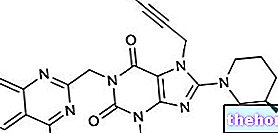
What is Ristaben?
Ristaben is a medicine that contains the active substance sitagliptin and is available in round tablets (pink 25 mg, beige 50 and 100 mg).
The medicine is identical to Januvia, which is already authorized in the European Union (EU). The manufacturer of Januvia has agreed that the scientific data relating to it are also used for Ristaben (“informed consent”).
What is Ristaben used for?
Ristaben is used in patients with type 2 diabetes to improve the control of the level of glucose (sugar) in the blood, as a complement to diet and exercise, in the following ways:
• on its own in patients whose diet and exercise do not allow for sufficient control and who are not suitable for treatment with metformin (an antidiabetic);
• in combination with metformin or a PPAR-gamma agonist (type of antidiabetic) such as thiazolidinedione in patients insufficiently controlled on metformin or the PPAR-gamma agonist alone;
• in combination with a sulfonylurea (another type of antidiabetic) in patients insufficiently controlled on sulfonylurea alone and unsuitable for treatment with metformin;
• in combination with metformin and a sulphonylurea or a PPAR-gamma agonist in patients insufficiently controlled with the two drugs;
• in combination with insulin, with or without metformin, in patients insufficiently controlled on a fixed dose of insulin.
The medicine can only be obtained with a prescription.
How is Ristaben used?
The recommended dose of Ristaben is 100 mg once a day, to be taken with or without food. If Ristaben is taken in combination with a sulfonylurea or insulin, the dose of the latter may need to be reduced to reduce the risk of hypoglycaemia (low blood sugar).
How does Ristaben work?
Type 2 diabetes is a disease in which the pancreas does not produce enough insulin to control the level of glucose in the blood or where the body cannot use the available insulin effectively. The active substance in Ristaben, sitagliptin, is a dipeptidyl-peptidase-4 (DPP 4) inhibitor and works by blocking the breakdown in the body of 'incretins', hormones released after meals that stimulate insulin production in the pancreas. the incretins in the blood sitagliptin stimulates the pancreas to produce more insulin where the blood sugar is too high. Sitagliptin is not effective if the blood sugar is low. Sitagliptin also reduces the amount of glucose produced by the liver by increasing insulin and reducing levels glucagon, a hormone. Together these processes lower blood sugar and help control type 2 diabetes.
How has Ristaben been studied?
Ristaben has been studied in nine studies involving nearly 6,000 patients with type 2 diabetes and insufficiently controlled blood glucose:
• four of these studies compared Ristaben with placebo (a dummy treatment). Ristaben or placebo was used alone in two studies involving a total of 1,262 patients, as an add-on to metformin in a study involving 701 patients and as an adjunct to pioglitazone (PPAR-gamma agonist) in a study involving 353 patients;
• two studies compared Ristaben with other diabetes medicines. One study compared Ristaben and glipizide (a sulphonylurea) as add-on treatments to metformin in 1,172 patients. The other study compared Ristaben and metformin, used alone, in 1,058 patients;
• three other studies compared Ristaben and placebo used as an add-on to other antidiabetics: glimepiride (a sulphonylurea), with or without metformin, in 441 patients; the combination metformin / rosiglitazone (PPAR-gamma agonist) on 278 patients; a fixed dose of insulin, with or without metformin, on 641 patients.
In all of the studies, the main measure of effectiveness was the effect of the medicines on the blood levels of a particular substance, glycosylated hemoglobin (HbA1c), which is indicative of the effectiveness of blood glucose control.
What benefit has Ristaben shown during the studies?
Ristaben was more effective than placebo when taken alone or in combination with other diabetes medicines. From about 8.0% at the start of the study, HbA1c levels fell by 0.48% after 18 weeks and by 0.61% after 24 weeks in patients taking Ristaben alone. 0.12% and 0.18% respectively in patients treated with placebo.
Adding Ristaben to metformin reduced HbA1c levels by 0.67% after 24 weeks, compared with a reduction of 0.02% in patients who had been added to placebo. Adding Ristaben to pioglitazone reduced the HbA1c levels of 0.85% after 24 weeks, compared with a reduction of 0.15% in patients who had been added to placebo.
In studies comparing Ristaben to other drugs, the effect of adding Ristaben to metformin was similar to that of adding glipizide. Taken alone, Ristaben and metformin induced similar reductions in HbA1c levels, although Ristaben appeared to be slightly less effective than metformin.
In the other studies, the addition of Ristaben to glimepiride (with or without metformin) resulted in a 0.45% decrease in HbA1c levels after 24 weeks, compared with the 0.28% increase seen in patients in whom it had been added the placebo. HbA1c levels were reduced by 1.03% after 18 weeks in patients who had Ristaben added to metformin and rosiglitazone compared with a reduction of 0.31% in patients who were added to placebo. 0.59% in patients who had Ristaben added to insulin (with or without metformin) compared with a 0.03% reduction in patients with added placebo.
What are the risks associated with Ristaben?
The most common side effects associated with Ristaben (usually seen in more than 5% of patients) include upper respiratory tract infections (cooling) and nasopharyngitis (inflammation of the nose and throat). For the full list of side effects reported with Ristaben, see the Package Leaflet.
Ristaben should not be used in patients who may be hypersensitive (allergic) to sitagliptin or any of the other ingredients.
Why has Ristaben been approved?
The Committee for Medicinal Products for Human Use (CHMP) decided that Ristaben's benefits are greater than its risks and recommended that it be given marketing authorization.
More information about Ristaben
On March 15, 2010, the European Commission granted Merck Sharp & Dohme Ltd. a "Marketing Authorization" for Ristaben, valid throughout the European Union. The "Marketing Authorization" is valid for five years, after of which it can be renewed.
For the full version of Ristaben's EPAR click here. For more information on Ristaben therapy, read the package leaflet (included with the EPAR).
Last update of this summary: 01-2010.
The information on Ristaben published on this page may be out of date or incomplete. For a correct use of this information, see the Disclaimer and useful information page.









.jpg)


















